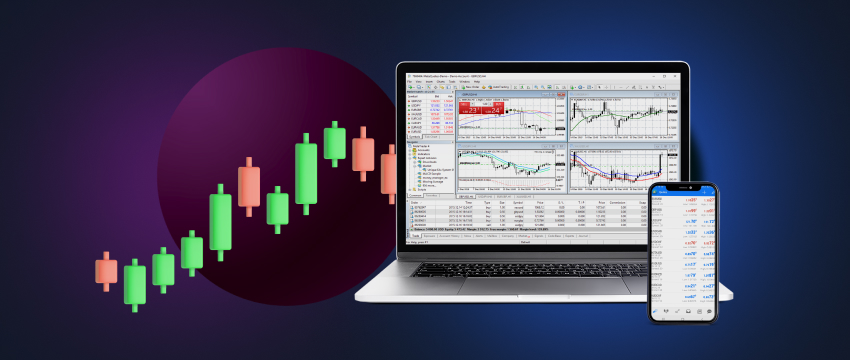Forex day traders use two main methods to determine buy or sell decisions on currency pairs: technical analysis, used by technical traders through charting tools, and fundamental analysis, which relies on economic trading indicators and news-based events.
In this article, we’ll explain how traders use technical analysis to trade in the forex market.
O que é a análise técnica?
Technical analysis is the study of price movements. The idea is that the current market price already reflects all available information, and traders use past price movements to identify current trading conditions and predict potential price movements.
You might have heard the phrase “It’s all in the charts.” This means the market has already priced in all known fundamental information. Technical traders rely on charts to analyse price action, identify patterns and trends to guide their trading decisions.
Technical analysis looks at the rhythm, flow, and trends in price action. It is based on the idea that “History tends to repeat itself.”
For instance, forex traders often watch out for a certain price. This price is held as a major support or resistance level in the past. They then base their trades around that historical price level.
Technical traders look for similar patterns that have formed in the past. As a result, they expect price to behave in the same way that it did previously.
Rather than prediction, technical analysis is about identifying possibilities. This is based on what happened before. By studying historical price action, traders aim to spot patterns and determine the potential future direction of price movement.

Why technical traders use charts
Technical traders, or technical analysts, use forex charts because they are the easiest way to visualise historical data.
People often refer to them as chartists. They believe price action is the most reliable indicator of future price movements.
Analysis assumptions for technical traders
Technical analysis tries to understand the market sentiment behind price trends by studying price patterns and trends. Charles Dow, one of the first to write about technical analysis, made two basic assumptions.
These assumptions still guide traders today:
- Markets are efficient with prices reflecting factors that affect the value of an asset.
- Price movements often form patterns and trends that repeat over time.
Today, technical analysis builds on the concepts introduced by Dow. It follows three general assumptions:
1. The market discounts everything:
Technical traders believe that everything, from interest rates, economic data, and market psychology, is already priced into currency values.
Similar to the Efficient Markets Hypothesis, the only thing left to analyse is how the price of a currency pair moves. Therefore, this becomes the focus of attention.
2. Prices follow trends:
Technical traders expect prices to follow trends, even in random markets. Many forex strategies are based on the assumption. Once a currency starts trending, it is more likely to keep moving in that direction. Therefore, it is less likely to reverse suddenly.
3. History repeats itself:
Price patterns often repeat. This happens because of market psychology. Market psychology tends to be very predictable. It is based on feelings such as fear or excitement. To understand trends, technical traders use chart patterns to examine these emotions and price movements.
How technical analysis is used in forex
Technical analysis can be applied to any financial market which has historical trading data. This includes forex currencies, futuros, ações, commodities, and fixed-income securities.
It is particularly popular in forex and commodities markets. This is because traders often focus on short-term price changes.
The goal of technical analysis is to predict the price movement of almost any instrument. This is done with the analysis of supply and demand.
While it mainly focuses on price changes, many technical traders follow numbers. These numbers include figures such as open interest or trading volume. Instead of just price, they rely on these additional indicators.

Common indicators used by technical traders
Researchers have developed lots of patterns and signals to help technical analysis trading. They have also created a variety of trading systems to help them predict and trade on price movements.
Certain indicators focus mainly on identifying the current market trend, which includes areas of support and resistance. Other indicators focus on assessing how strong a trend is and the probability that it will continue.
Linhas de Tendência, channels, moving averages, e momentum indicators are some examples of widely used technical indicators e charting patterns.
In general, technical traders look at indicators like the ones below:
- Price trends
- Chart patterns
- Volume and momentum indicators
- Oscillators
- Médias móveis
- Níveis de suporte e de resistência
Learning technical analysis
Understanding technical analysis needs the right educational materials, structured courses, and hands-on experience.
Online courses, books and free platforms can help traders to learn everything they need to know about technical analysis.
Online and offline courses for technical traders
When checking out technical analysis courses, it’s important to make sure the content is good quality and credible.
There are many options for traders to choose from, which include beginner friendly platforms like Coursera and Udemy to the specialised Chartered Market Technician (CMT) and Certified Financial Technician (CFTe) programs.
Reputable educators place a strong focus on the fundamentals of technical analysis, real-market applications, and effective risk management.
They will also avoid making unrealistic claims. Specifically, they will avoid claims about guaranteed profits.
Educational websites
Another way to develop a strong understanding of technical analysis is by using free online resources. These resources provide good educational content. Additionally, they help avoid the need to pay high costs.
Many platforms provide thorough overviews of technical analysis concepts, indicators, and chart patterns. Therefore, this makes them good places to get started in forex trading. Investopedia, Tradingview, and Charts School are some of the best online resources.
The role of technology
Technology has drastically changed the way traders use technical analysis and has made it more efficient and accessible. It also proves the value and usefulness of indicators e chart patterns.
Advanced charting tools, customisation features, and even paper trading accounts are available on online platforms. Traders that have different varying levels of experience can make the use of accessible learning opportunities offered by online resources, brokerage education centres, and interactive webinars.
Social media platforms also make it easier for traders to learn from peers. In addition, they allow traders to learn from experts. For those traders interested in automation, there are apps which makes it possible to build and run rules-based strategies with consistency, removing emotional bias.
Automated trading tools and demo accounts have made the transition from theory to actual trading easier. With advanced technology, investors and traders can effectively develop, test, and apply effective trading strategies before they commit to the markets.
Latest tech advances in forex analysis for technical traders
Technical analysis tools have been greatly improved by recent technological advancement, and this has made the tools more effective for traders.
The integration of AI and machine learning has enabled predictive modelling. This allows it to recognise complex patterns. Meanwhile, advanced charting platforms now provide enhanced customisation. In addition, they offer real-time visualisation and pattern recognition.

Conclusão
A good way to learn technical analysis is by combining both traditional educational resources with modern tools.
A comprehensive learning approach includes understanding fundamental concepts through reputable courses. It also involves using interactive platforms for practical experience.
Additionally, it requires keeping up with the latest technological advancements. These include AI-enhanced analysis and mobile charting tools.
By combining theory, consistent practice on demo accounts, and the latest technological advancements, traders will be better equipped to make confident trading decisions in the forex market.
AVISO LEGAL: A informação disposta não deve ser interpretada como consultoria financeira ou recomendação de investimento, sendo apresentada apenas para fins de comunicação e marketing.




